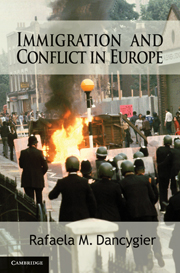Book contents
- Frontmatter
- Contents
- List of Figures and Tables
- Acknowledgments
- PART I GENERAL INTRODUCTION AND THEORETICAL FRAMEWORK
- PART II INTRODUCTION TO PART II
- 3 Patterns of Immigrant Conflict in Great Britain
- 4 Dynamics of Racist Violence
- PART III INTRODUCTION TO PART III
- PART IV INTRODUCTION TO PART IV
- 9 Conclusion
- Appendix A Coding Large-Scale Instances of Immigrant–Native and Immigrant–State Violence
- Appendix B Data and Variables: Immigrant Turnout
- References
- Index
- Titles in the series
4 - Dynamics of Racist Violence
Published online by Cambridge University Press: 17 November 2010
- Frontmatter
- Contents
- List of Figures and Tables
- Acknowledgments
- PART I GENERAL INTRODUCTION AND THEORETICAL FRAMEWORK
- PART II INTRODUCTION TO PART II
- 3 Patterns of Immigrant Conflict in Great Britain
- 4 Dynamics of Racist Violence
- PART III INTRODUCTION TO PART III
- PART IV INTRODUCTION TO PART IV
- 9 Conclusion
- Appendix A Coding Large-Scale Instances of Immigrant–Native and Immigrant–State Violence
- Appendix B Data and Variables: Immigrant Turnout
- References
- Index
- Titles in the series
Summary
In Chapter 3, we saw that the occurrence of large-scale violent clashes between immigrant-origin minorities and natives and immigrant-origin minorities and the state has varied across groups, cities, and over time. Intergroup and antistate confrontations on a smaller scale appear to track these patterns: South Asians often became targets of racist harassment, while low-level flare-ups involving state actors and ethnic minorities were particularly common among West Indians. Both faces of immigrant conflict became increasingly prevalent during the 1970s and 1980s, as economic conditions deteriorated, and they were also more likely to take place in Britain's most economically disadvantaged neighborhoods.
This chapter homes in on one of the aforementioned indicators of immigrant conflict: the incidence of everyday racist attacks, perpetuated by individuals acting alone or in small groups. I pursue two aims. First, I demonstrate that this type of violence correlates with another indicator of intergroup conflict, namely the presence of xenophobic political parties at the local level. Some have questioned the nature of this relationship, arguing, for example, that individuals are likely to resort to racist crime when no extremist parties are available to take up their grievances, or that such crime is guided by irrational impulses that do not follow political trends (see the subsequent text). Research on far-right parties in turn suggests that voters who support extremist organizations may do so in part to protest the political establishment, rather than to voice concerns about immigration or the ethnic diversity it brings about (cf. Mudde 2007, 226–229).
- Type
- Chapter
- Information
- Immigration and Conflict in Europe , pp. 102 - 128Publisher: Cambridge University PressPrint publication year: 2010

